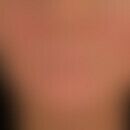Synonym(s)
DefinitionThis section has been translated automatically.
Manifestation form of a zoophilic dermatophyte infection with less inflammatory or more inflammatory, disc-like, erythematous foci on the face.
PathogenThis section has been translated automatically.
You might also be interested in
ManifestationThis section has been translated automatically.
children between 5-10 LJ, also teenagers
Clinical featuresThis section has been translated automatically.
Mostly uncharacteristic (usually "steroidally" pretreated), 0.5-5.0 cm large, red but also reddish-brown, scaly, mostly itchy, possibly also weeping, only moderately elevated, borderline plaques.
Diagnostically groundbreaking are scattered 0.2-0.4 cm red follicular papules or papulopustules.
In individual patients, however, highly red, flat-exposed plaques, usually interspersed with follicular pustules, may also be present.
Hair can be easily extracted from these plaques. These show a cuff of hyphae and spores in the native preparation.
Frequently, tinea lesions can also be detected on other skin areas (e.g. tinea corporis et faciei).
Differential diagnosisThis section has been translated automatically.
TherapyThis section has been translated automatically.
Note(s)This section has been translated automatically.
Experience shows that a systemic therapy is necessary (e.g. Terbinafine). It is recommended to search for nail mycoses ("autoinoculation").
For children animal contact anamnesis! Cave infected "cuddly toys".
LiteratureThis section has been translated automatically.
- Czaika VA (2013) Misdiagnosed zoophilic tinea faciei and tinea corporis effectively treated with isoconazole nitrate and diflucortolone valerate combination therapy. Mycoses 56 Suppl 1:26-29
- Ishizaki S et al(2012) Tinea faciei by Microsporum gypseum mimicking allergic reaction following cosmetic tattooing of the eyebrows. Med Mycol J 53:263-266
- Kang D et al (2013) Impetigo-like tinea faciei around the nostrils caused by Arthroderma vanbreuseghemii identified using polymerase chain reaction-based sequencing of crusts. Pediatric Dermatol 30:e136-37
- Kieliger S et al (2014) Tinea capitis and tinea faciei in the Zurich area - an 8-year survey of trends in the epidemiology and treatment patterns. J Eur Acad Dermatol Venereol doi: 10.1111/jdv.12908
- Nenoff P et al (2014) Images in clinical medicine. Tinea faciei. N Engl J Med 370:e31
- Viera MH et al (2013) Inflammatory tinea faciei mimicking Sweet's syndrome. Actas Dermosifiliogr 104:75-76
Incoming links (4)
Benhamiae trichophyton; Lupus erythematodes chronicus discoides; Pityriasis alba pigmenting; Tinea corporis;Outgoing links (11)
Atopic dermatitis (overview); Contagious impetigo; Cutaneous lupus erythematosus (overview); Facial granuloma; Microsporum canis; Psoriasis vulgaris; Rosacea; Terbinafine; Tinea corporis; Trichophyton mentagrophytes; ... Show allDisclaimer
Please ask your physician for a reliable diagnosis. This website is only meant as a reference.













